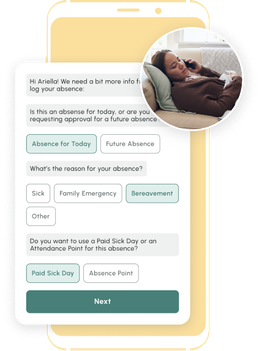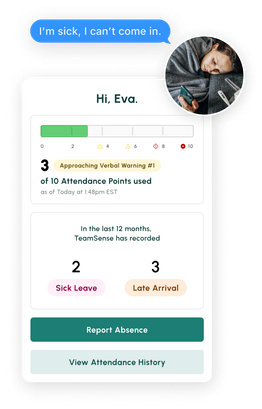Fix the root cause of No-Call No-Show with help from TeamSense
If you've ever felt like managing employee attendance is a tightrope walk, you're not alone. From unexpected absences to chronic tardiness to no call, no shows, these issues can be tricky to navigate.
The pressure of being in charge can be overwhelming, especially when you are the one ensuring that employees adhere to attendance policies. When faced with recurrent absenteeism or tardiness, it's essential to address the issue professionally and consistently. Enter the attendance write up, your tool for addressing these problems in a professional and constructive way. If you're scratching your head wondering how to create one, don't worry. This blog post is here to help you. We're breaking down the process step-by-step, and we're even including some handy attendance write up examples to illustrate the process. Ready to dive in? Let's get started!
What is an Employee Attendance Write Up?
An employee attendance write up is a formal document that details an employee's attendance issue over a specific period. It serves as part of a progressive disciplinary process aimed at encouraging regular attendance, thereby enhancing overall productivity and fostering a positive work environment.
Reasons to Write-Up An Employee: When to Take Disciplinary Action
Employee attendance write-ups serve as necessary documentation to manage and address persistent absenteeism. One of the main reasons for implementation is to maintain a healthy work environment. Absences not only impact an employee's productivity but also disrupt workflow, which could lead to a negative ripple effect on the whole team.
According to a study1 conducted by the Society for Human Resource Management (SHRM), 59% of HR professionals claim unscheduled absences have a large impact on their organization’s overall productivity levels. Furthermore, 37% report absenteeism affecting their workplace’s morale.
Think about a game of Jenga where each block represents an employee. If one block is removed or displaced, it affects the stability of the entire structure and makes it more prone to collapse. There are several situations where an employee's attendance may become problematic and necessitate a formal write-up. Understanding these scenarios can help you address attendance issues proactively and fairly.
Here are some of the most common reasons for issuing an employee attendance write-up:
- Unexcused Absences: When an employee fails to show up for work without a valid excuse or proper notification, it's time for a write-up.
- Persistent Tardiness: The habit of clocking in late can disrupt workflows and impact team morale. Regular tardiness should be addressed with a formal notice.
- Excessive Absenteeism: Even with valid reasons, frequent absences can hamper productivity and warrant an attendance write-up.
- Patterned Absences: Consistent absences on certain days, like Mondays or Fridays, or around holidays can signal an attendance problem.
- Premature Departures: Regularly leaving work before the end of the shift without valid reasons can be grounds for a write-up.
- Extended Breaks: Taking longer breaks than allowed by company policy can disrupt work schedules and may necessitate formal action.
- No Call, No Show: One of the most serious attendance offenses, failing to show up for work without any notice, typically calls for immediate disciplinary action, including a write-up.
Always remember that the situations in which you issue an attendance write-up should be based on your company's established policies and procedures. By being consistent and fair in your approach, you can effectively reduce absenteeism, fostering a culture of responsibility and respect in your organization.

No one wants to talk to their boss or a 1-800 stranger to call off. Text changes everything - Reducing No Call No Shows.
How to Write an Effective Employee Attendance Write Up: A Step-by-step Guide
Now to the main course - crafting that effective write up. Here's how:
Step 1: Document the Attendance Issue
Firstly, gather your facts. Record when the employee is late, absent, or leaves early without permission - unbiased, accurate data is your friend here.
Step 2: Include Essential Information
Ensure your write up has the employee's name, department, the date of the write-up, and the specifics of the attendance issue.
Step 3: Describe the Impact
Pen down how the employee's absence or tardiness has a ripple effect on the team's performance, deadlines, or overall productivity.
Step 4: Reference Company Policies
Bring in the rule book. Highlight the relevant company policy on absenteeism and tardiness, reminding the employee of their responsibility to adhere to these rules. If your company has an attendance points policy, reference that as well.
Step 5: Provide an Opportunity for Improvement
Here's where you extend an olive branch - outline steps for the employee to improve their attendance. Set a reasonable timeframe for this improvement and outline potential consequences if there's no progress.
Step 6: Obtain Signatures
Last but not least, get that all-important signature from the employee. This confirms that they've read and understood the write-up. Keep a copy in their personnel file and hand another to the employee.
Attendance Write Up Examples
As promised, here's an 'attendance write up example' to make this process crystal clear:
Example 1 - General Attendance Write Up:
[Employee’s Name]
[Department]
[Date]
Subject: Employee Attendance Write Up
This write-up addresses your ongoing attendance issues, specifically unexcused absences on [insert dates] and tardiness on [insert dates].
Your consistent absenteeism and tardiness put a strain on team productivity and create additional workloads for your colleagues. As outlined in our Employee Handbook under Section [insert section], maintaining regular attendance is crucial for smooth operations.
We hope to see an improvement in your attendance going forward. If unexcused absences or lateness continue beyond the next [insert timeframe], we may have to consider further disciplinary actions, potentially including termination.
By signing this document, you acknowledge the attendance issues stated above and commit to improving your punctuality and attendance.
Employee’s Signature:_____________________________ Date:__________________
Manager’s Signature:_____________________________ Date:__________________

Is your call-in process terrible? Text reduces no-shows and absenteeism by up to 40%.
Don't believe us? Check out this case study to see how this 3PL benefited.
Example 2 - Manufacturing Attendance Write Up:
[Employee’s Name]
[Position]
[Department]
[Date]
Subject: Employee Attendance Write Up
Dear [Employee’s Name],
This write-up addresses your ongoing attendance issues, specifically relating to your role in our manufacturing department.
Over the past [insert time period], we have noted multiple instances of unexcused absences and tardiness, specifically on [insert dates]. Additionally, you left early on [insert dates] without prior approval from your supervisor.
Your consistent attendance issues are impacting the efficiency of our production line. As a key part of our assembly team, your unavailability puts additional strain on your colleagues and disrupts the continuity of our manufacturing process. This has led to missed deadlines, slower production times, and increased workload for your fellow team members.
As outlined in our Employee Handbook under Section [insert section], maintaining regular attendance is crucial, particularly in a manufacturing environment where every team member plays a pivotal role in the timely delivery of our products.
We highly value your contribution to our team, and we would like to see improvement in your attendance. We suggest you [insert proposed steps for improvement] over the next [insert timeframe]. If unexcused absences, tardiness, or early departures continue beyond this period, we may need to consider further disciplinary actions, potentially up to and including termination.
We are open to discuss any extenuating circumstances that might be contributing to your attendance issues and explore potential solutions or supports where appropriate.
By signing this document, you acknowledge the attendance issues stated above and commit to improving your punctuality and overall attendance.
Employee’s Signature:_____________________________ Date:__________________
Manager’s Signature:_____________________________ Date:__________________
Example 3 - Completed Attendance Write Up:
Employee’s Name: John Doe
Position: Assembly Line Operator
Department: Production
Date: June 7, 2023
Subject: Employee Attendance Write Up
Dear John,
This letter serves as a formal notice concerning your ongoing attendance issues. As an Assembly Line Operator in our production department, your role is vital to maintaining the efficiency of our manufacturing processes.
Over the past three months, we have noted unexcused absences on April 12, May 8, and May 21. Additionally, you were tardy on March 31, April 29, and May 17, and left early without approval on May 24 and June 1.
Your consistent attendance issues have had a significant impact on the efficiency of our production line. As a critical member of our assembly team, your absences and tardiness have put additional strain on your colleagues and disrupted our manufacturing process. This disruption has resulted in delayed production schedules on April 12, May 8, and May 21, and consequently increased the workload for your fellow team members.
As outlined in our Employee Handbook under Section 3.2, regular attendance is paramount, especially in a manufacturing environment where each team member plays an essential role in the timely delivery of our products.
We highly value your contribution to our team and would like to see an improvement in your attendance. We ask that you ensure regular punctuality, inform your supervisor ahead of any potential absences, and avoid leaving early without prior approval over the next three months. If unexcused absences, tardiness, or early departures continue beyond this period, we may need to consider further disciplinary actions, potentially up to and including termination.
If there are extenuating circumstances contributing to your attendance issues, please feel free to discuss them with your supervisor or HR. We are committed to providing support where possible to assist our team members.
By signing this document, you acknowledge the attendance issues stated above and commit to improving your punctuality and overall attendance.
Employee’s Signature:_____________________________ Date:__________________
Manager’s Signature:_____________________________ Date:__________________
This comprehensive write-up clearly communicates the attendance issues and the implications, while also providing an avenue for the employee to improve. Remember, the aim is to foster a constructive dialogue and improvement, not simply to be reprimanded.
How To Document Attendance Issues
Employees should be held accountable for their actions, but managers and supervisors must ensure that any warnings or consequences are administered fairly and documented properly.
An effective write-up system should take several factors into account, including whether the employee has explicit documentation of previous written attendance warnings and discussions. The write-up should provide as much detail as possible about the reason for the absence or tardiness and whether it affected the employee's work tasks or deadlines. It should also specify what improvements are expected moving forward.
It is also essential to avoid generalizing employees' behavior and instead use customized language based on individual circumstances and histories. Moreover, it is important not to dismiss any potential underlying context surrounding the employee's absence.
By considering these nuances, senior staff can evaluate more holistically why an employee may have had attendance problems rather than rushing to utilize disciplinary action immediately following policy violations.
Just as doctors perform extra tests before diagnosing a patient with a terminal illness, managers must assess every situation comprehensively instead of instantaneously apportioning blame through standardized attendance violation procedures.

Tips To Improve Employee Attendance: Building a Culture That Inspires Commitment
While our guide to writing an effective employee attendance write up is a crucial tool for managers, we hope that it's a tool you'll rarely have to use. In an ideal world, each member of your team would arrive on time, every day, fully ready to contribute their best.
To inch closer to that ideal, it's crucial to foster a company culture that inspires your employees to show up for work, not because they have to, but because they genuinely want to. Here are some tips to help improve employee attendance, reduce absenteeism, and create an engaging work environment:
1. Communicate Expectations Clearly:
Ensure your employees fully understand the company's attendance policy. Include it in the employee handbook, discuss it during onboarding, and revisit it in team meetings as needed.
2. Prioritize Work-Life Balance:
Overworked employees are more likely to take unplanned time off. Encourage a healthy work-life balance by implementing flexible schedules, or providing sufficient vacation time.
3. Recognize Good Attendance:
Rewarding employees who consistently maintain good attendance can motivate others to do the same. This recognition could be through an 'Employee of the Month' program or other types of rewards.
4. Provide a Healthy Working Environment:
Safe, comfortable, and well-equipped workspaces can help reduce absences related to workplace discomfort or injury.
5. Foster Employee Engagement:
Employees are more likely to show up when they feel connected to their work and their team. Regular team-building activities, feedback sessions, and inclusive decision-making processes can help improve engagement.
6. Offer Opportunities for Growth:
If employees see opportunities for advancement in their role, they are less likely to be absent. Regular training and development opportunities can help keep your team motivated and focused.
7. Address Issues Promptly:
If an employee starts to show attendance issues, address it as soon as possible. Open, respectful communication can often help resolve problems before they become habitual.
Improving employee attendance isn't about strict rules and severe punishments. Instead, it's about cultivating a culture of accountability where employees feel valued, engaged, and integral to the company's mission. When employees feel a genuine commitment to their role and team, showing up on time, every day, becomes the norm, that everyone expects to follow.
About the Author

Sheila Stafford, CEO of TeamSense & AI in HR Innovator
As CEO of TeamSense, Sheila Stafford is at the forefront of transforming HR for frontline teams through AI-driven solutions. With a commitment to enhancing employee relations and simplifying workforce management, Sheila leads TeamSense in pioneering advancements that empower both frontline employees and HR teams. Her visionary approach combines cutting-edge technology with a thoughtful focus on enhancing human connection; Sheila strategically implements AI where it adds the most value while recognizing the critical role of personal interaction and ensuring that human engagement remains central when it matters most. Under her leadership, TeamSense is redefining how companies support and engage their frontline teams for a more connected, efficient workplace.





